Taxation Law: Assessing the Effects of Labor's Dividend Reform Policy
VerifiedAdded on 2021/06/17
|14
|3622
|32
Report
AI Summary
This report provides a comprehensive analysis of the dividend imputation system in Australia, focusing on the proposed reforms by the Labor party. It discusses the existing system, where companies can issue franked dividends, allowing shareholders to offset franking credits against their tax liabilities. The report then delves into Labor's proposal to remove the ability for individuals and superannuation funds to receive refunds for excess franking credits, assessing the potential effects on taxpayers, particularly self-managed super funds and low-income retirees. Furthermore, the report examines the advantages and disadvantages of Labor's policy, highlighting its potential impact on wealth inequality and the government's budget, while also discussing the attributes of a good tax system. The analysis concludes by emphasizing the need for a tax system that promotes overall economic development and fiscal adequacy.
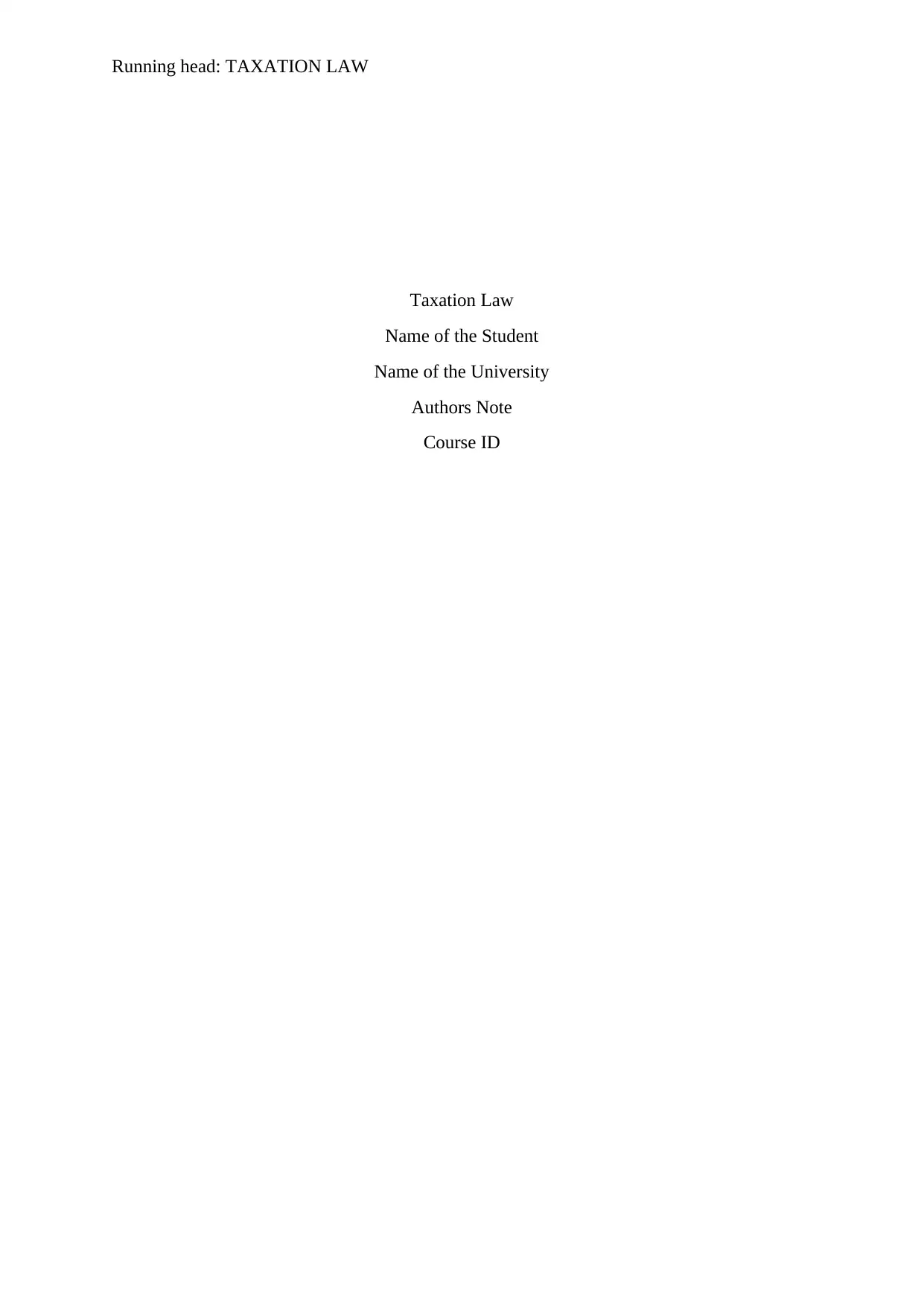
Running head: TAXATION LAW
Taxation Law
Name of the Student
Name of the University
Authors Note
Course ID
Taxation Law
Name of the Student
Name of the University
Authors Note
Course ID
Paraphrase This Document
Need a fresh take? Get an instant paraphrase of this document with our AI Paraphraser
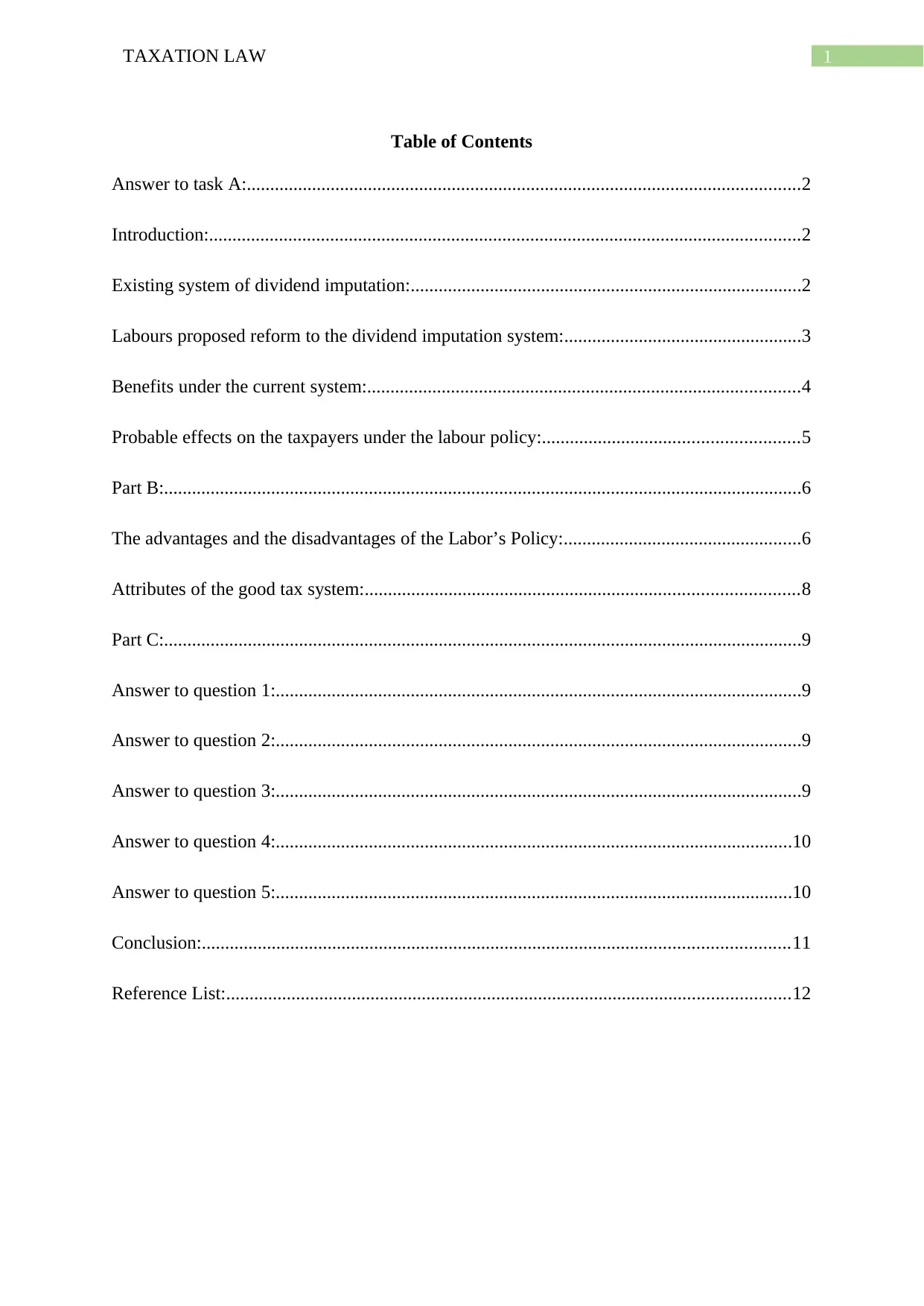
1TAXATION LAW
Table of Contents
Answer to task A:.......................................................................................................................2
Introduction:...............................................................................................................................2
Existing system of dividend imputation:....................................................................................2
Labours proposed reform to the dividend imputation system:...................................................3
Benefits under the current system:.............................................................................................4
Probable effects on the taxpayers under the labour policy:.......................................................5
Part B:.........................................................................................................................................6
The advantages and the disadvantages of the Labor’s Policy:...................................................6
Attributes of the good tax system:.............................................................................................8
Part C:.........................................................................................................................................9
Answer to question 1:.................................................................................................................9
Answer to question 2:.................................................................................................................9
Answer to question 3:.................................................................................................................9
Answer to question 4:...............................................................................................................10
Answer to question 5:...............................................................................................................10
Conclusion:..............................................................................................................................11
Reference List:.........................................................................................................................12
Table of Contents
Answer to task A:.......................................................................................................................2
Introduction:...............................................................................................................................2
Existing system of dividend imputation:....................................................................................2
Labours proposed reform to the dividend imputation system:...................................................3
Benefits under the current system:.............................................................................................4
Probable effects on the taxpayers under the labour policy:.......................................................5
Part B:.........................................................................................................................................6
The advantages and the disadvantages of the Labor’s Policy:...................................................6
Attributes of the good tax system:.............................................................................................8
Part C:.........................................................................................................................................9
Answer to question 1:.................................................................................................................9
Answer to question 2:.................................................................................................................9
Answer to question 3:.................................................................................................................9
Answer to question 4:...............................................................................................................10
Answer to question 5:...............................................................................................................10
Conclusion:..............................................................................................................................11
Reference List:.........................................................................................................................12
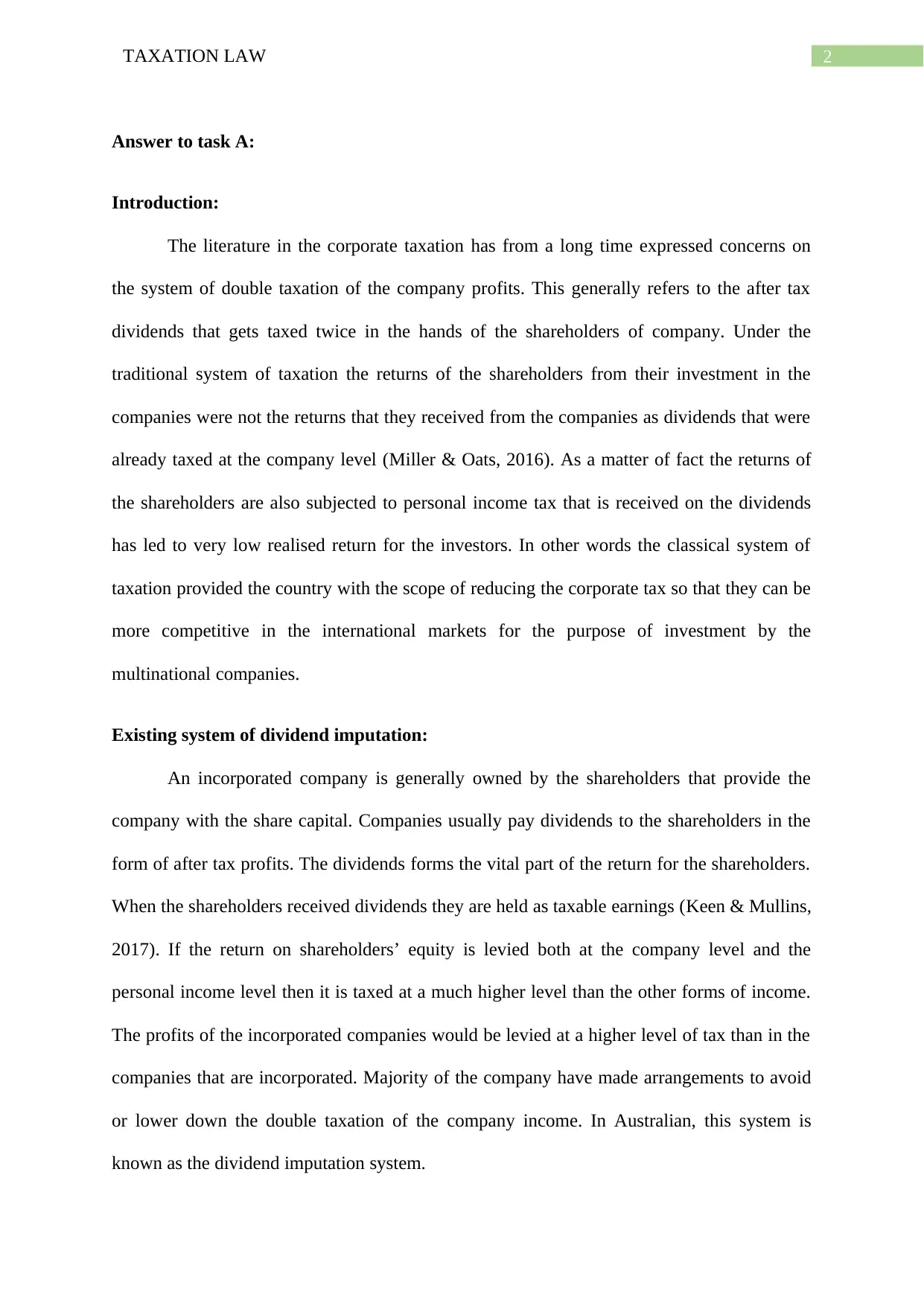
2TAXATION LAW
Answer to task A:
Introduction:
The literature in the corporate taxation has from a long time expressed concerns on
the system of double taxation of the company profits. This generally refers to the after tax
dividends that gets taxed twice in the hands of the shareholders of company. Under the
traditional system of taxation the returns of the shareholders from their investment in the
companies were not the returns that they received from the companies as dividends that were
already taxed at the company level (Miller & Oats, 2016). As a matter of fact the returns of
the shareholders are also subjected to personal income tax that is received on the dividends
has led to very low realised return for the investors. In other words the classical system of
taxation provided the country with the scope of reducing the corporate tax so that they can be
more competitive in the international markets for the purpose of investment by the
multinational companies.
Existing system of dividend imputation:
An incorporated company is generally owned by the shareholders that provide the
company with the share capital. Companies usually pay dividends to the shareholders in the
form of after tax profits. The dividends forms the vital part of the return for the shareholders.
When the shareholders received dividends they are held as taxable earnings (Keen & Mullins,
2017). If the return on shareholders’ equity is levied both at the company level and the
personal income level then it is taxed at a much higher level than the other forms of income.
The profits of the incorporated companies would be levied at a higher level of tax than in the
companies that are incorporated. Majority of the company have made arrangements to avoid
or lower down the double taxation of the company income. In Australian, this system is
known as the dividend imputation system.
Answer to task A:
Introduction:
The literature in the corporate taxation has from a long time expressed concerns on
the system of double taxation of the company profits. This generally refers to the after tax
dividends that gets taxed twice in the hands of the shareholders of company. Under the
traditional system of taxation the returns of the shareholders from their investment in the
companies were not the returns that they received from the companies as dividends that were
already taxed at the company level (Miller & Oats, 2016). As a matter of fact the returns of
the shareholders are also subjected to personal income tax that is received on the dividends
has led to very low realised return for the investors. In other words the classical system of
taxation provided the country with the scope of reducing the corporate tax so that they can be
more competitive in the international markets for the purpose of investment by the
multinational companies.
Existing system of dividend imputation:
An incorporated company is generally owned by the shareholders that provide the
company with the share capital. Companies usually pay dividends to the shareholders in the
form of after tax profits. The dividends forms the vital part of the return for the shareholders.
When the shareholders received dividends they are held as taxable earnings (Keen & Mullins,
2017). If the return on shareholders’ equity is levied both at the company level and the
personal income level then it is taxed at a much higher level than the other forms of income.
The profits of the incorporated companies would be levied at a higher level of tax than in the
companies that are incorporated. Majority of the company have made arrangements to avoid
or lower down the double taxation of the company income. In Australian, this system is
known as the dividend imputation system.
⊘ This is a preview!⊘
Do you want full access?
Subscribe today to unlock all pages.

Trusted by 1+ million students worldwide
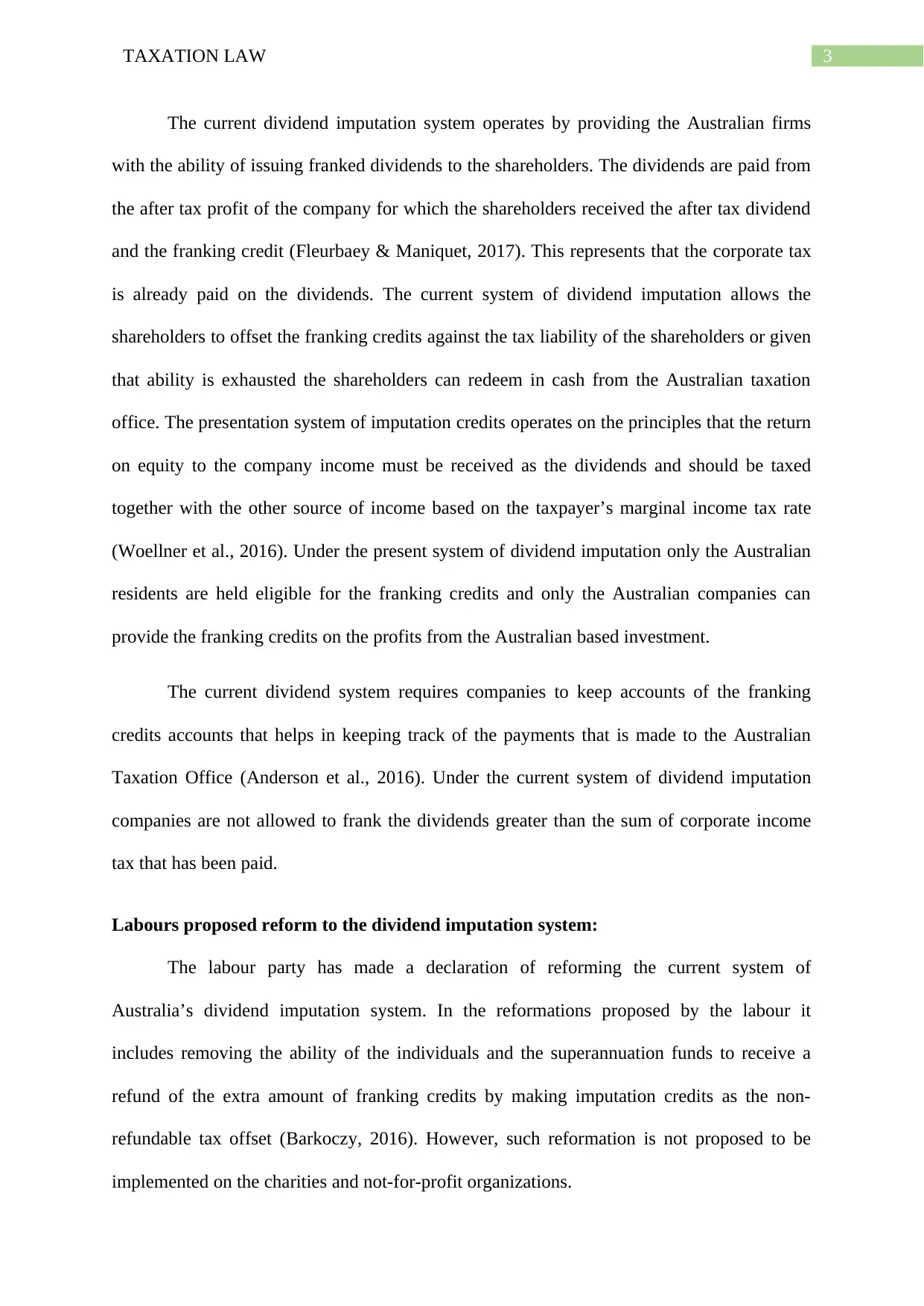
3TAXATION LAW
The current dividend imputation system operates by providing the Australian firms
with the ability of issuing franked dividends to the shareholders. The dividends are paid from
the after tax profit of the company for which the shareholders received the after tax dividend
and the franking credit (Fleurbaey & Maniquet, 2017). This represents that the corporate tax
is already paid on the dividends. The current system of dividend imputation allows the
shareholders to offset the franking credits against the tax liability of the shareholders or given
that ability is exhausted the shareholders can redeem in cash from the Australian taxation
office. The presentation system of imputation credits operates on the principles that the return
on equity to the company income must be received as the dividends and should be taxed
together with the other source of income based on the taxpayer’s marginal income tax rate
(Woellner et al., 2016). Under the present system of dividend imputation only the Australian
residents are held eligible for the franking credits and only the Australian companies can
provide the franking credits on the profits from the Australian based investment.
The current dividend system requires companies to keep accounts of the franking
credits accounts that helps in keeping track of the payments that is made to the Australian
Taxation Office (Anderson et al., 2016). Under the current system of dividend imputation
companies are not allowed to frank the dividends greater than the sum of corporate income
tax that has been paid.
Labours proposed reform to the dividend imputation system:
The labour party has made a declaration of reforming the current system of
Australia’s dividend imputation system. In the reformations proposed by the labour it
includes removing the ability of the individuals and the superannuation funds to receive a
refund of the extra amount of franking credits by making imputation credits as the non-
refundable tax offset (Barkoczy, 2016). However, such reformation is not proposed to be
implemented on the charities and not-for-profit organizations.
The current dividend imputation system operates by providing the Australian firms
with the ability of issuing franked dividends to the shareholders. The dividends are paid from
the after tax profit of the company for which the shareholders received the after tax dividend
and the franking credit (Fleurbaey & Maniquet, 2017). This represents that the corporate tax
is already paid on the dividends. The current system of dividend imputation allows the
shareholders to offset the franking credits against the tax liability of the shareholders or given
that ability is exhausted the shareholders can redeem in cash from the Australian taxation
office. The presentation system of imputation credits operates on the principles that the return
on equity to the company income must be received as the dividends and should be taxed
together with the other source of income based on the taxpayer’s marginal income tax rate
(Woellner et al., 2016). Under the present system of dividend imputation only the Australian
residents are held eligible for the franking credits and only the Australian companies can
provide the franking credits on the profits from the Australian based investment.
The current dividend system requires companies to keep accounts of the franking
credits accounts that helps in keeping track of the payments that is made to the Australian
Taxation Office (Anderson et al., 2016). Under the current system of dividend imputation
companies are not allowed to frank the dividends greater than the sum of corporate income
tax that has been paid.
Labours proposed reform to the dividend imputation system:
The labour party has made a declaration of reforming the current system of
Australia’s dividend imputation system. In the reformations proposed by the labour it
includes removing the ability of the individuals and the superannuation funds to receive a
refund of the extra amount of franking credits by making imputation credits as the non-
refundable tax offset (Barkoczy, 2016). However, such reformation is not proposed to be
implemented on the charities and not-for-profit organizations.
Paraphrase This Document
Need a fresh take? Get an instant paraphrase of this document with our AI Paraphraser
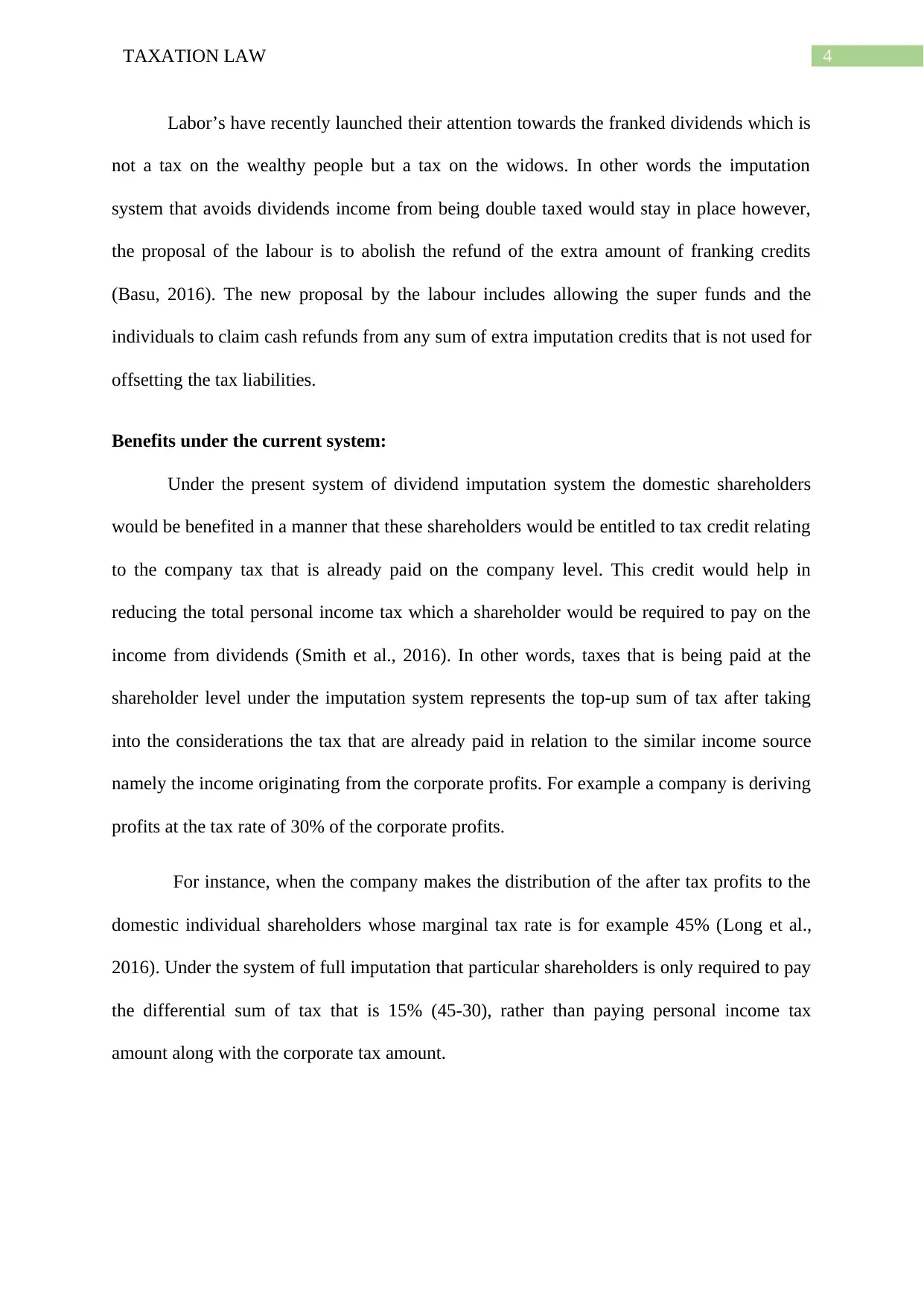
4TAXATION LAW
Labor’s have recently launched their attention towards the franked dividends which is
not a tax on the wealthy people but a tax on the widows. In other words the imputation
system that avoids dividends income from being double taxed would stay in place however,
the proposal of the labour is to abolish the refund of the extra amount of franking credits
(Basu, 2016). The new proposal by the labour includes allowing the super funds and the
individuals to claim cash refunds from any sum of extra imputation credits that is not used for
offsetting the tax liabilities.
Benefits under the current system:
Under the present system of dividend imputation system the domestic shareholders
would be benefited in a manner that these shareholders would be entitled to tax credit relating
to the company tax that is already paid on the company level. This credit would help in
reducing the total personal income tax which a shareholder would be required to pay on the
income from dividends (Smith et al., 2016). In other words, taxes that is being paid at the
shareholder level under the imputation system represents the top-up sum of tax after taking
into the considerations the tax that are already paid in relation to the similar income source
namely the income originating from the corporate profits. For example a company is deriving
profits at the tax rate of 30% of the corporate profits.
For instance, when the company makes the distribution of the after tax profits to the
domestic individual shareholders whose marginal tax rate is for example 45% (Long et al.,
2016). Under the system of full imputation that particular shareholders is only required to pay
the differential sum of tax that is 15% (45-30), rather than paying personal income tax
amount along with the corporate tax amount.
Labor’s have recently launched their attention towards the franked dividends which is
not a tax on the wealthy people but a tax on the widows. In other words the imputation
system that avoids dividends income from being double taxed would stay in place however,
the proposal of the labour is to abolish the refund of the extra amount of franking credits
(Basu, 2016). The new proposal by the labour includes allowing the super funds and the
individuals to claim cash refunds from any sum of extra imputation credits that is not used for
offsetting the tax liabilities.
Benefits under the current system:
Under the present system of dividend imputation system the domestic shareholders
would be benefited in a manner that these shareholders would be entitled to tax credit relating
to the company tax that is already paid on the company level. This credit would help in
reducing the total personal income tax which a shareholder would be required to pay on the
income from dividends (Smith et al., 2016). In other words, taxes that is being paid at the
shareholder level under the imputation system represents the top-up sum of tax after taking
into the considerations the tax that are already paid in relation to the similar income source
namely the income originating from the corporate profits. For example a company is deriving
profits at the tax rate of 30% of the corporate profits.
For instance, when the company makes the distribution of the after tax profits to the
domestic individual shareholders whose marginal tax rate is for example 45% (Long et al.,
2016). Under the system of full imputation that particular shareholders is only required to pay
the differential sum of tax that is 15% (45-30), rather than paying personal income tax
amount along with the corporate tax amount.
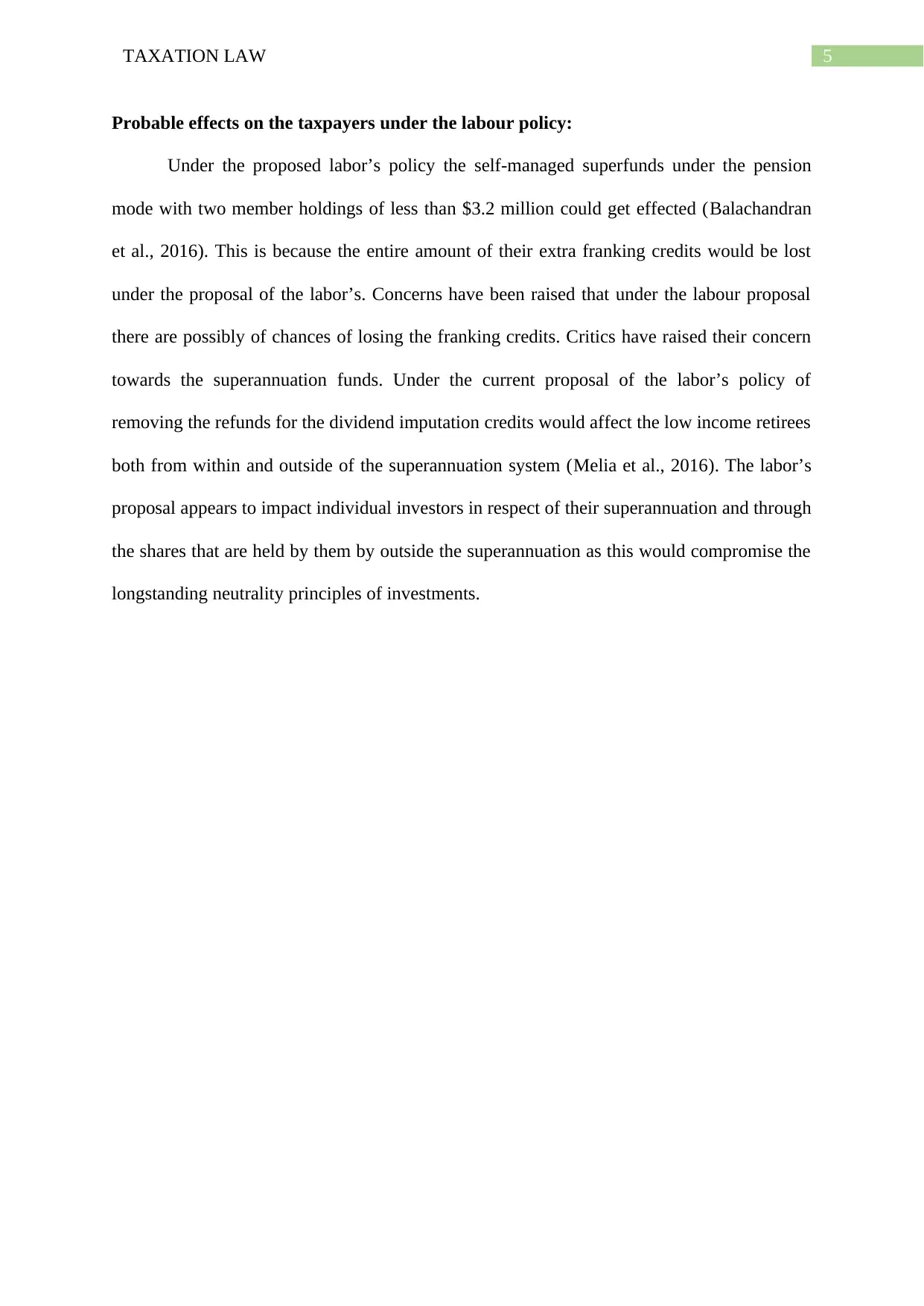
5TAXATION LAW
Probable effects on the taxpayers under the labour policy:
Under the proposed labor’s policy the self-managed superfunds under the pension
mode with two member holdings of less than $3.2 million could get effected (Balachandran
et al., 2016). This is because the entire amount of their extra franking credits would be lost
under the proposal of the labor’s. Concerns have been raised that under the labour proposal
there are possibly of chances of losing the franking credits. Critics have raised their concern
towards the superannuation funds. Under the current proposal of the labor’s policy of
removing the refunds for the dividend imputation credits would affect the low income retirees
both from within and outside of the superannuation system (Melia et al., 2016). The labor’s
proposal appears to impact individual investors in respect of their superannuation and through
the shares that are held by them by outside the superannuation as this would compromise the
longstanding neutrality principles of investments.
Probable effects on the taxpayers under the labour policy:
Under the proposed labor’s policy the self-managed superfunds under the pension
mode with two member holdings of less than $3.2 million could get effected (Balachandran
et al., 2016). This is because the entire amount of their extra franking credits would be lost
under the proposal of the labor’s. Concerns have been raised that under the labour proposal
there are possibly of chances of losing the franking credits. Critics have raised their concern
towards the superannuation funds. Under the current proposal of the labor’s policy of
removing the refunds for the dividend imputation credits would affect the low income retirees
both from within and outside of the superannuation system (Melia et al., 2016). The labor’s
proposal appears to impact individual investors in respect of their superannuation and through
the shares that are held by them by outside the superannuation as this would compromise the
longstanding neutrality principles of investments.
⊘ This is a preview!⊘
Do you want full access?
Subscribe today to unlock all pages.

Trusted by 1+ million students worldwide
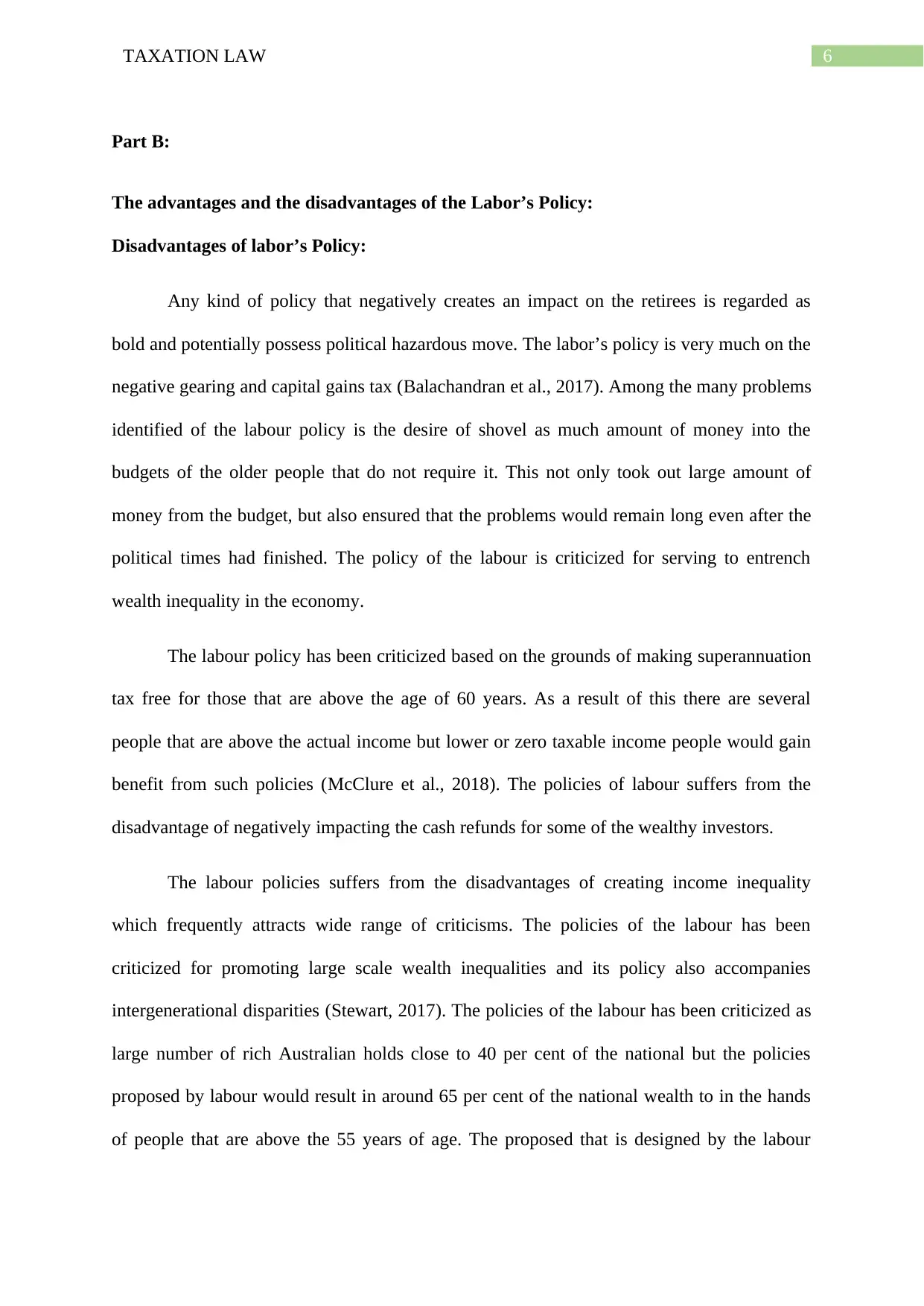
6TAXATION LAW
Part B:
The advantages and the disadvantages of the Labor’s Policy:
Disadvantages of labor’s Policy:
Any kind of policy that negatively creates an impact on the retirees is regarded as
bold and potentially possess political hazardous move. The labor’s policy is very much on the
negative gearing and capital gains tax (Balachandran et al., 2017). Among the many problems
identified of the labour policy is the desire of shovel as much amount of money into the
budgets of the older people that do not require it. This not only took out large amount of
money from the budget, but also ensured that the problems would remain long even after the
political times had finished. The policy of the labour is criticized for serving to entrench
wealth inequality in the economy.
The labour policy has been criticized based on the grounds of making superannuation
tax free for those that are above the age of 60 years. As a result of this there are several
people that are above the actual income but lower or zero taxable income people would gain
benefit from such policies (McClure et al., 2018). The policies of labour suffers from the
disadvantage of negatively impacting the cash refunds for some of the wealthy investors.
The labour policies suffers from the disadvantages of creating income inequality
which frequently attracts wide range of criticisms. The policies of the labour has been
criticized for promoting large scale wealth inequalities and its policy also accompanies
intergenerational disparities (Stewart, 2017). The policies of the labour has been criticized as
large number of rich Australian holds close to 40 per cent of the national but the policies
proposed by labour would result in around 65 per cent of the national wealth to in the hands
of people that are above the 55 years of age. The proposed that is designed by the labour
Part B:
The advantages and the disadvantages of the Labor’s Policy:
Disadvantages of labor’s Policy:
Any kind of policy that negatively creates an impact on the retirees is regarded as
bold and potentially possess political hazardous move. The labor’s policy is very much on the
negative gearing and capital gains tax (Balachandran et al., 2017). Among the many problems
identified of the labour policy is the desire of shovel as much amount of money into the
budgets of the older people that do not require it. This not only took out large amount of
money from the budget, but also ensured that the problems would remain long even after the
political times had finished. The policy of the labour is criticized for serving to entrench
wealth inequality in the economy.
The labour policy has been criticized based on the grounds of making superannuation
tax free for those that are above the age of 60 years. As a result of this there are several
people that are above the actual income but lower or zero taxable income people would gain
benefit from such policies (McClure et al., 2018). The policies of labour suffers from the
disadvantage of negatively impacting the cash refunds for some of the wealthy investors.
The labour policies suffers from the disadvantages of creating income inequality
which frequently attracts wide range of criticisms. The policies of the labour has been
criticized for promoting large scale wealth inequalities and its policy also accompanies
intergenerational disparities (Stewart, 2017). The policies of the labour has been criticized as
large number of rich Australian holds close to 40 per cent of the national but the policies
proposed by labour would result in around 65 per cent of the national wealth to in the hands
of people that are above the 55 years of age. The proposed that is designed by the labour
Paraphrase This Document
Need a fresh take? Get an instant paraphrase of this document with our AI Paraphraser
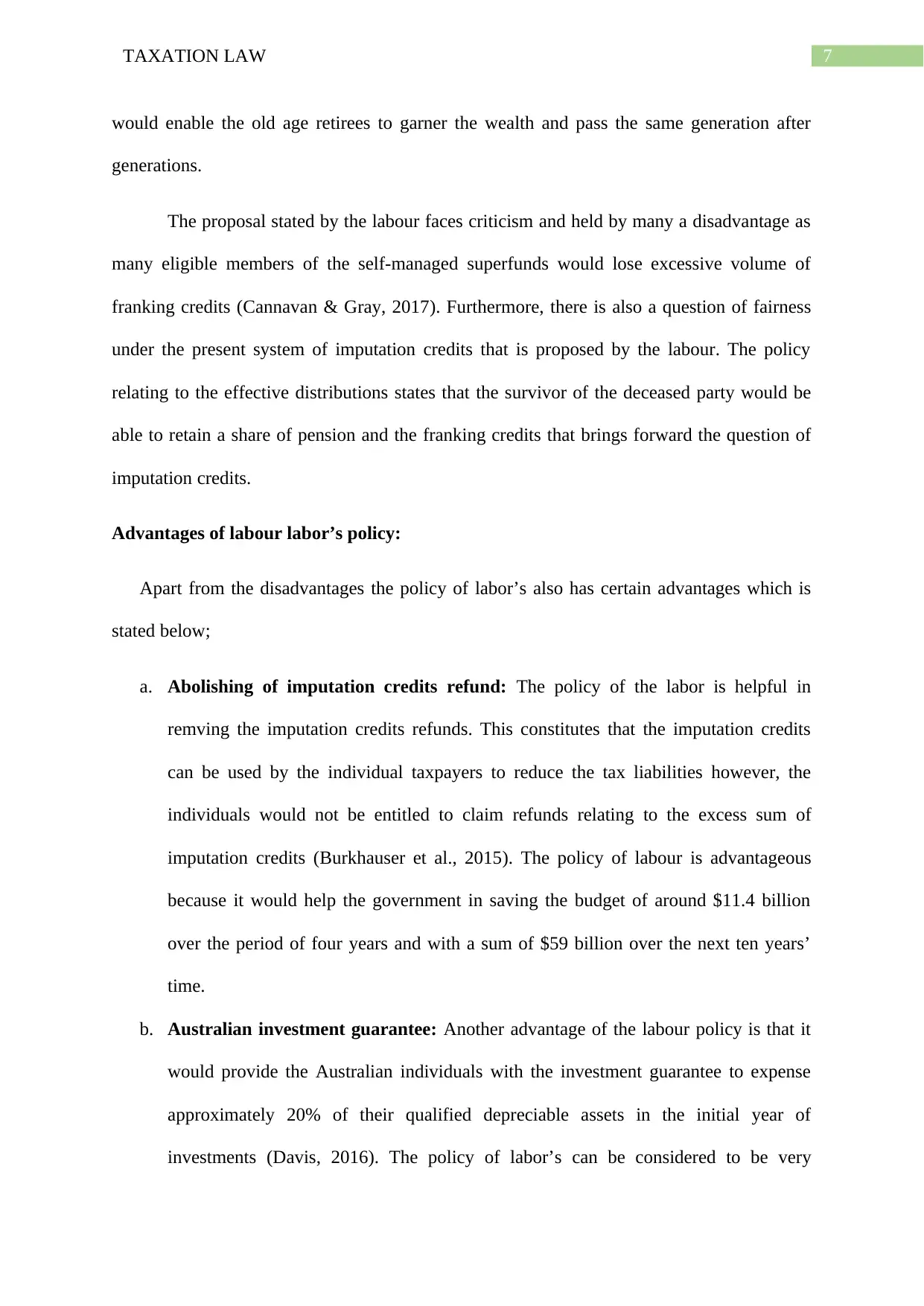
7TAXATION LAW
would enable the old age retirees to garner the wealth and pass the same generation after
generations.
The proposal stated by the labour faces criticism and held by many a disadvantage as
many eligible members of the self-managed superfunds would lose excessive volume of
franking credits (Cannavan & Gray, 2017). Furthermore, there is also a question of fairness
under the present system of imputation credits that is proposed by the labour. The policy
relating to the effective distributions states that the survivor of the deceased party would be
able to retain a share of pension and the franking credits that brings forward the question of
imputation credits.
Advantages of labour labor’s policy:
Apart from the disadvantages the policy of labor’s also has certain advantages which is
stated below;
a. Abolishing of imputation credits refund: The policy of the labor is helpful in
remving the imputation credits refunds. This constitutes that the imputation credits
can be used by the individual taxpayers to reduce the tax liabilities however, the
individuals would not be entitled to claim refunds relating to the excess sum of
imputation credits (Burkhauser et al., 2015). The policy of labour is advantageous
because it would help the government in saving the budget of around $11.4 billion
over the period of four years and with a sum of $59 billion over the next ten years’
time.
b. Australian investment guarantee: Another advantage of the labour policy is that it
would provide the Australian individuals with the investment guarantee to expense
approximately 20% of their qualified depreciable assets in the initial year of
investments (Davis, 2016). The policy of labor’s can be considered to be very
would enable the old age retirees to garner the wealth and pass the same generation after
generations.
The proposal stated by the labour faces criticism and held by many a disadvantage as
many eligible members of the self-managed superfunds would lose excessive volume of
franking credits (Cannavan & Gray, 2017). Furthermore, there is also a question of fairness
under the present system of imputation credits that is proposed by the labour. The policy
relating to the effective distributions states that the survivor of the deceased party would be
able to retain a share of pension and the franking credits that brings forward the question of
imputation credits.
Advantages of labour labor’s policy:
Apart from the disadvantages the policy of labor’s also has certain advantages which is
stated below;
a. Abolishing of imputation credits refund: The policy of the labor is helpful in
remving the imputation credits refunds. This constitutes that the imputation credits
can be used by the individual taxpayers to reduce the tax liabilities however, the
individuals would not be entitled to claim refunds relating to the excess sum of
imputation credits (Burkhauser et al., 2015). The policy of labour is advantageous
because it would help the government in saving the budget of around $11.4 billion
over the period of four years and with a sum of $59 billion over the next ten years’
time.
b. Australian investment guarantee: Another advantage of the labour policy is that it
would provide the Australian individuals with the investment guarantee to expense
approximately 20% of their qualified depreciable assets in the initial year of
investments (Davis, 2016). The policy of labor’s can be considered to be very
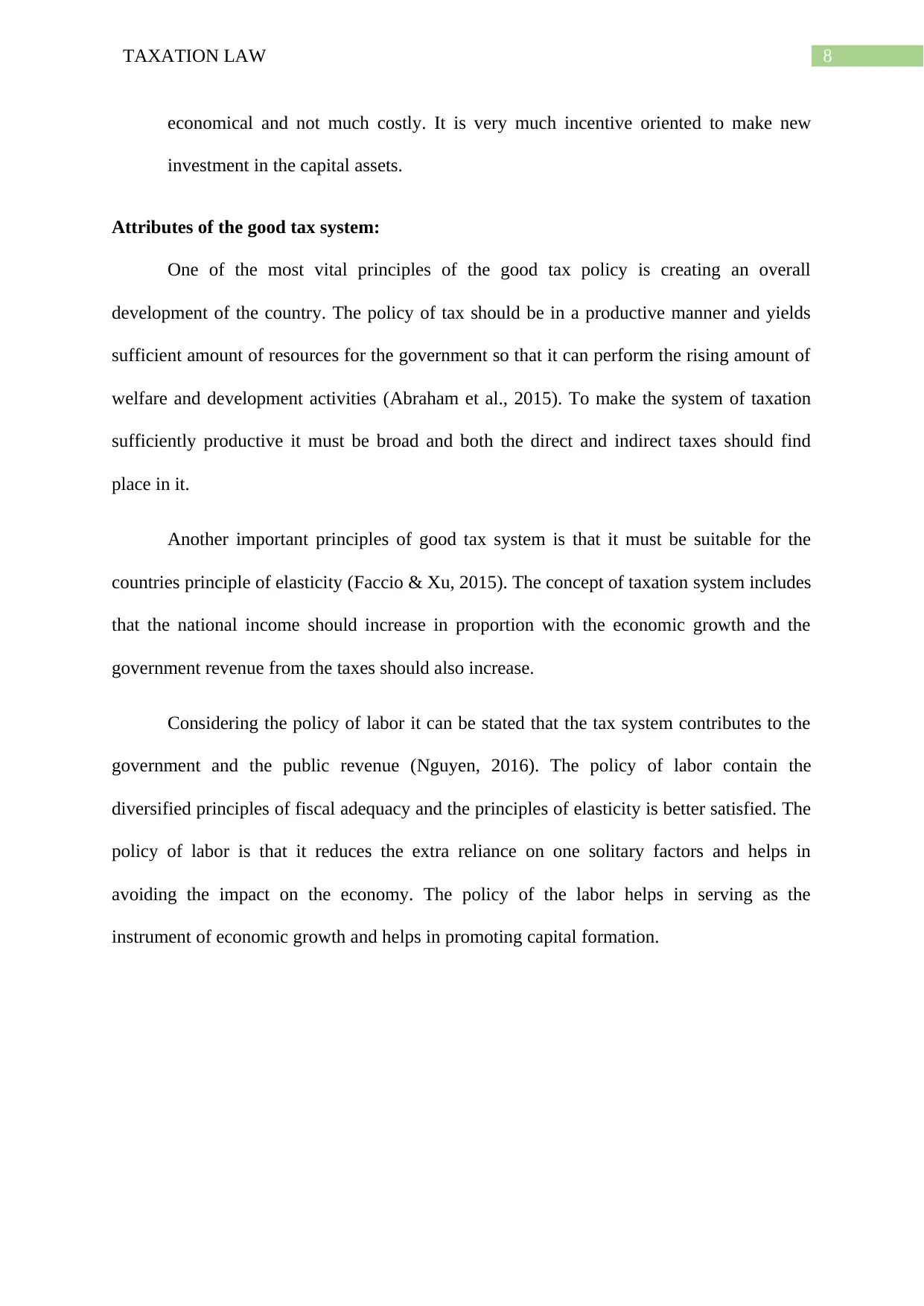
8TAXATION LAW
economical and not much costly. It is very much incentive oriented to make new
investment in the capital assets.
Attributes of the good tax system:
One of the most vital principles of the good tax policy is creating an overall
development of the country. The policy of tax should be in a productive manner and yields
sufficient amount of resources for the government so that it can perform the rising amount of
welfare and development activities (Abraham et al., 2015). To make the system of taxation
sufficiently productive it must be broad and both the direct and indirect taxes should find
place in it.
Another important principles of good tax system is that it must be suitable for the
countries principle of elasticity (Faccio & Xu, 2015). The concept of taxation system includes
that the national income should increase in proportion with the economic growth and the
government revenue from the taxes should also increase.
Considering the policy of labor it can be stated that the tax system contributes to the
government and the public revenue (Nguyen, 2016). The policy of labor contain the
diversified principles of fiscal adequacy and the principles of elasticity is better satisfied. The
policy of labor is that it reduces the extra reliance on one solitary factors and helps in
avoiding the impact on the economy. The policy of the labor helps in serving as the
instrument of economic growth and helps in promoting capital formation.
economical and not much costly. It is very much incentive oriented to make new
investment in the capital assets.
Attributes of the good tax system:
One of the most vital principles of the good tax policy is creating an overall
development of the country. The policy of tax should be in a productive manner and yields
sufficient amount of resources for the government so that it can perform the rising amount of
welfare and development activities (Abraham et al., 2015). To make the system of taxation
sufficiently productive it must be broad and both the direct and indirect taxes should find
place in it.
Another important principles of good tax system is that it must be suitable for the
countries principle of elasticity (Faccio & Xu, 2015). The concept of taxation system includes
that the national income should increase in proportion with the economic growth and the
government revenue from the taxes should also increase.
Considering the policy of labor it can be stated that the tax system contributes to the
government and the public revenue (Nguyen, 2016). The policy of labor contain the
diversified principles of fiscal adequacy and the principles of elasticity is better satisfied. The
policy of labor is that it reduces the extra reliance on one solitary factors and helps in
avoiding the impact on the economy. The policy of the labor helps in serving as the
instrument of economic growth and helps in promoting capital formation.
⊘ This is a preview!⊘
Do you want full access?
Subscribe today to unlock all pages.

Trusted by 1+ million students worldwide
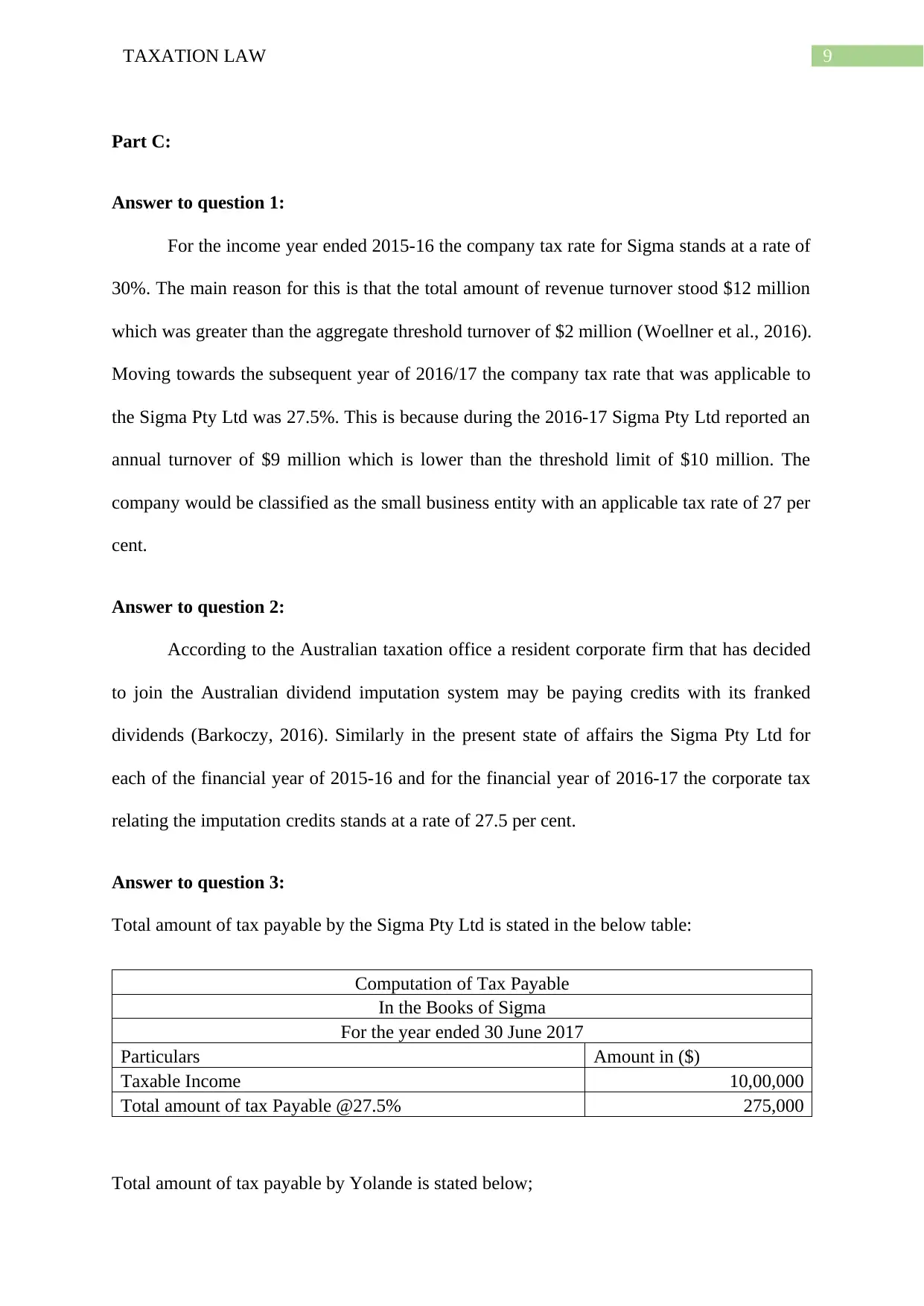
9TAXATION LAW
Part C:
Answer to question 1:
For the income year ended 2015-16 the company tax rate for Sigma stands at a rate of
30%. The main reason for this is that the total amount of revenue turnover stood $12 million
which was greater than the aggregate threshold turnover of $2 million (Woellner et al., 2016).
Moving towards the subsequent year of 2016/17 the company tax rate that was applicable to
the Sigma Pty Ltd was 27.5%. This is because during the 2016-17 Sigma Pty Ltd reported an
annual turnover of $9 million which is lower than the threshold limit of $10 million. The
company would be classified as the small business entity with an applicable tax rate of 27 per
cent.
Answer to question 2:
According to the Australian taxation office a resident corporate firm that has decided
to join the Australian dividend imputation system may be paying credits with its franked
dividends (Barkoczy, 2016). Similarly in the present state of affairs the Sigma Pty Ltd for
each of the financial year of 2015-16 and for the financial year of 2016-17 the corporate tax
relating the imputation credits stands at a rate of 27.5 per cent.
Answer to question 3:
Total amount of tax payable by the Sigma Pty Ltd is stated in the below table:
Computation of Tax Payable
In the Books of Sigma
For the year ended 30 June 2017
Particulars Amount in ($)
Taxable Income 10,00,000
Total amount of tax Payable @27.5% 275,000
Total amount of tax payable by Yolande is stated below;
Part C:
Answer to question 1:
For the income year ended 2015-16 the company tax rate for Sigma stands at a rate of
30%. The main reason for this is that the total amount of revenue turnover stood $12 million
which was greater than the aggregate threshold turnover of $2 million (Woellner et al., 2016).
Moving towards the subsequent year of 2016/17 the company tax rate that was applicable to
the Sigma Pty Ltd was 27.5%. This is because during the 2016-17 Sigma Pty Ltd reported an
annual turnover of $9 million which is lower than the threshold limit of $10 million. The
company would be classified as the small business entity with an applicable tax rate of 27 per
cent.
Answer to question 2:
According to the Australian taxation office a resident corporate firm that has decided
to join the Australian dividend imputation system may be paying credits with its franked
dividends (Barkoczy, 2016). Similarly in the present state of affairs the Sigma Pty Ltd for
each of the financial year of 2015-16 and for the financial year of 2016-17 the corporate tax
relating the imputation credits stands at a rate of 27.5 per cent.
Answer to question 3:
Total amount of tax payable by the Sigma Pty Ltd is stated in the below table:
Computation of Tax Payable
In the Books of Sigma
For the year ended 30 June 2017
Particulars Amount in ($)
Taxable Income 10,00,000
Total amount of tax Payable @27.5% 275,000
Total amount of tax payable by Yolande is stated below;
Paraphrase This Document
Need a fresh take? Get an instant paraphrase of this document with our AI Paraphraser
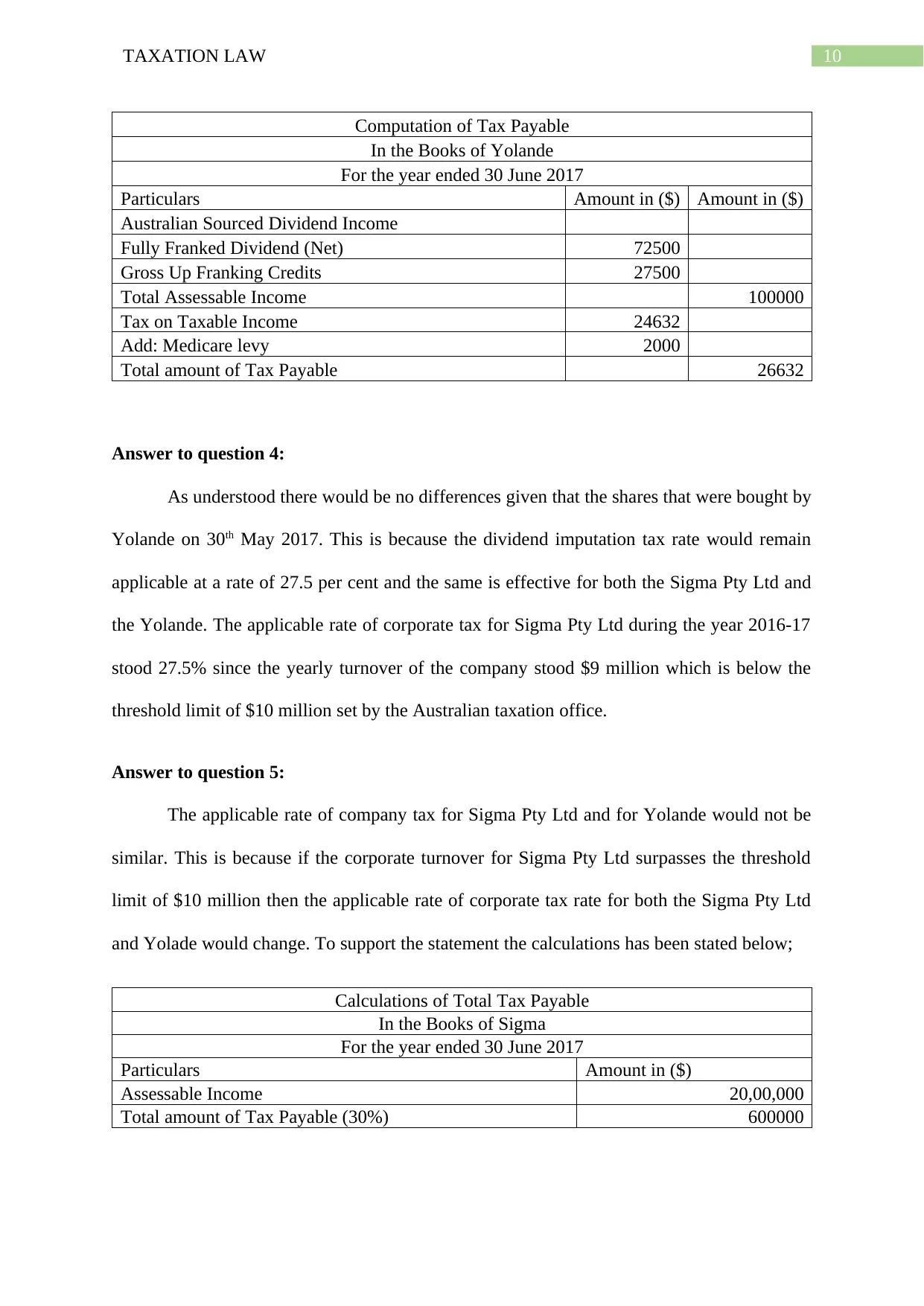
10TAXATION LAW
Computation of Tax Payable
In the Books of Yolande
For the year ended 30 June 2017
Particulars Amount in ($) Amount in ($)
Australian Sourced Dividend Income
Fully Franked Dividend (Net) 72500
Gross Up Franking Credits 27500
Total Assessable Income 100000
Tax on Taxable Income 24632
Add: Medicare levy 2000
Total amount of Tax Payable 26632
Answer to question 4:
As understood there would be no differences given that the shares that were bought by
Yolande on 30th May 2017. This is because the dividend imputation tax rate would remain
applicable at a rate of 27.5 per cent and the same is effective for both the Sigma Pty Ltd and
the Yolande. The applicable rate of corporate tax for Sigma Pty Ltd during the year 2016-17
stood 27.5% since the yearly turnover of the company stood $9 million which is below the
threshold limit of $10 million set by the Australian taxation office.
Answer to question 5:
The applicable rate of company tax for Sigma Pty Ltd and for Yolande would not be
similar. This is because if the corporate turnover for Sigma Pty Ltd surpasses the threshold
limit of $10 million then the applicable rate of corporate tax rate for both the Sigma Pty Ltd
and Yolade would change. To support the statement the calculations has been stated below;
Calculations of Total Tax Payable
In the Books of Sigma
For the year ended 30 June 2017
Particulars Amount in ($)
Assessable Income 20,00,000
Total amount of Tax Payable (30%) 600000
Computation of Tax Payable
In the Books of Yolande
For the year ended 30 June 2017
Particulars Amount in ($) Amount in ($)
Australian Sourced Dividend Income
Fully Franked Dividend (Net) 72500
Gross Up Franking Credits 27500
Total Assessable Income 100000
Tax on Taxable Income 24632
Add: Medicare levy 2000
Total amount of Tax Payable 26632
Answer to question 4:
As understood there would be no differences given that the shares that were bought by
Yolande on 30th May 2017. This is because the dividend imputation tax rate would remain
applicable at a rate of 27.5 per cent and the same is effective for both the Sigma Pty Ltd and
the Yolande. The applicable rate of corporate tax for Sigma Pty Ltd during the year 2016-17
stood 27.5% since the yearly turnover of the company stood $9 million which is below the
threshold limit of $10 million set by the Australian taxation office.
Answer to question 5:
The applicable rate of company tax for Sigma Pty Ltd and for Yolande would not be
similar. This is because if the corporate turnover for Sigma Pty Ltd surpasses the threshold
limit of $10 million then the applicable rate of corporate tax rate for both the Sigma Pty Ltd
and Yolade would change. To support the statement the calculations has been stated below;
Calculations of Total Tax Payable
In the Books of Sigma
For the year ended 30 June 2017
Particulars Amount in ($)
Assessable Income 20,00,000
Total amount of Tax Payable (30%) 600000
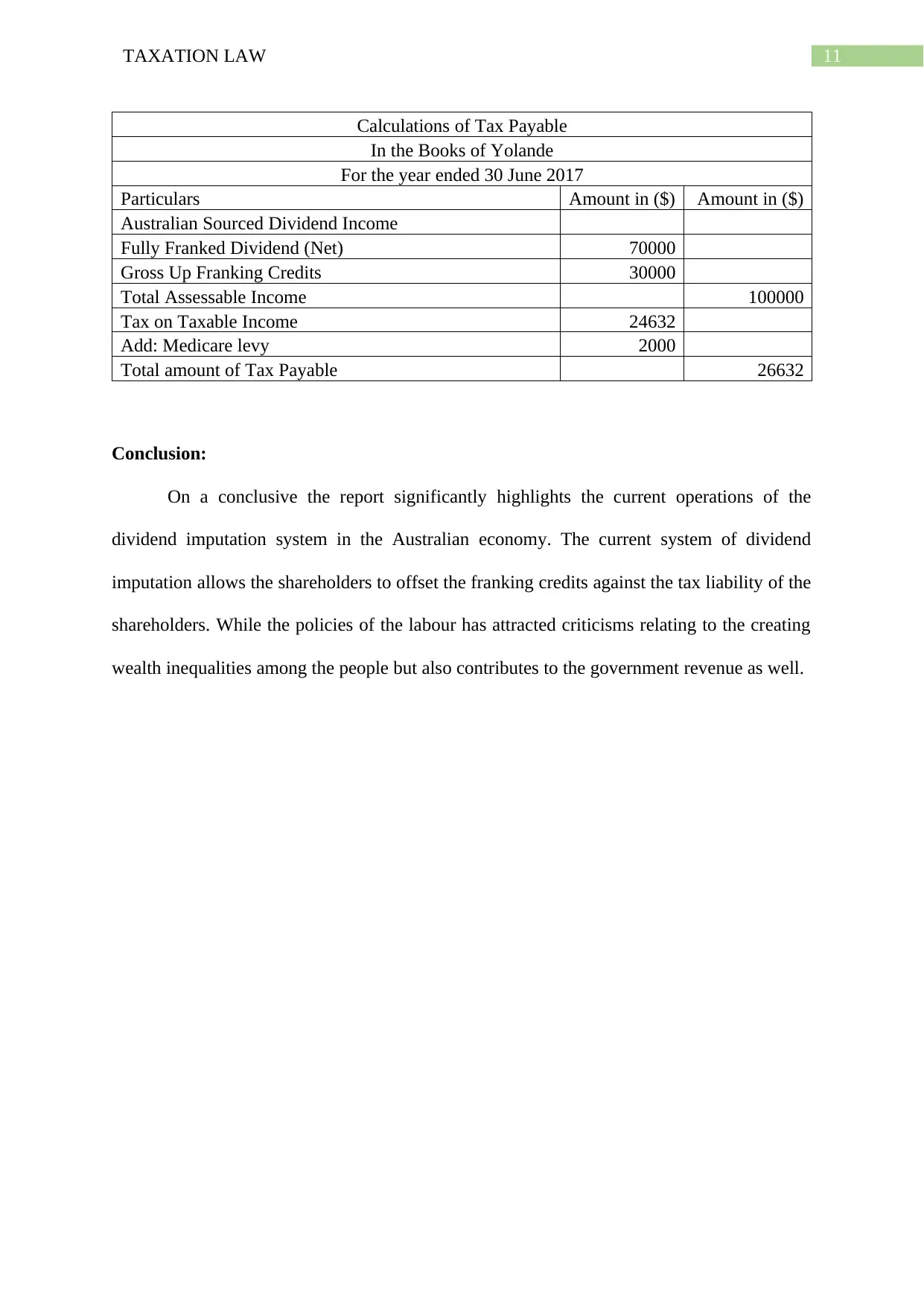
11TAXATION LAW
Calculations of Tax Payable
In the Books of Yolande
For the year ended 30 June 2017
Particulars Amount in ($) Amount in ($)
Australian Sourced Dividend Income
Fully Franked Dividend (Net) 70000
Gross Up Franking Credits 30000
Total Assessable Income 100000
Tax on Taxable Income 24632
Add: Medicare levy 2000
Total amount of Tax Payable 26632
Conclusion:
On a conclusive the report significantly highlights the current operations of the
dividend imputation system in the Australian economy. The current system of dividend
imputation allows the shareholders to offset the franking credits against the tax liability of the
shareholders. While the policies of the labour has attracted criticisms relating to the creating
wealth inequalities among the people but also contributes to the government revenue as well.
Calculations of Tax Payable
In the Books of Yolande
For the year ended 30 June 2017
Particulars Amount in ($) Amount in ($)
Australian Sourced Dividend Income
Fully Franked Dividend (Net) 70000
Gross Up Franking Credits 30000
Total Assessable Income 100000
Tax on Taxable Income 24632
Add: Medicare levy 2000
Total amount of Tax Payable 26632
Conclusion:
On a conclusive the report significantly highlights the current operations of the
dividend imputation system in the Australian economy. The current system of dividend
imputation allows the shareholders to offset the franking credits against the tax liability of the
shareholders. While the policies of the labour has attracted criticisms relating to the creating
wealth inequalities among the people but also contributes to the government revenue as well.
⊘ This is a preview!⊘
Do you want full access?
Subscribe today to unlock all pages.

Trusted by 1+ million students worldwide
1 out of 14
Related Documents
Your All-in-One AI-Powered Toolkit for Academic Success.
+13062052269
info@desklib.com
Available 24*7 on WhatsApp / Email
![[object Object]](/_next/static/media/star-bottom.7253800d.svg)
Unlock your academic potential
Copyright © 2020–2025 A2Z Services. All Rights Reserved. Developed and managed by ZUCOL.





